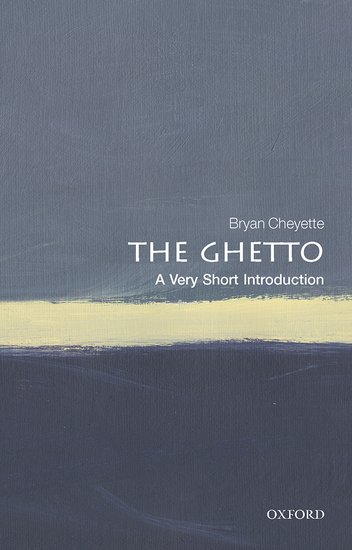Home >
A Very Short Introduction >
The Ghetto (History)
A Very Short Introduction | History
The Ghetto
ISBN: 9780198809951
Series: A Very Short Introduction
The Ghetto (History)
A Very Short Introduction The Ghetto (History) Media > Books > Non-Fiction > Education Books Expect Delays of Up to 4 Weeks| Order Below |
ISBN
9780198809951 (10-digit ISBN: 0198809956)
- Description
- Key Features
- Series Description
- Table of Contents
- Covers the varying histories of different kinds of ghettos - urban, racial, and colonial
- Considers the identity of the people in ghettos, and why and how ghetto communities are formed
- Analyses the appearance of ghettos in popular culture
- Shows how both the experience of ghettoization and the memory of ghettos impacts people living in them
For three hundred years the ghetto defined Jewish culture in the late medieval and early modern period in Western Europe. In the nineteenth-century it was a free-floating concept which travelled to Eastern Europe and the United States. Eastern European "ghettos", which enabled genocide, were crudely rehabilitated by the Nazis during World War Two as if they were part of a benign medieval tradition. In the United States, the word ghetto was routinely applied to endemic black ghettoization which has lasted from 1920 until the present. Outside of America "the ghetto" has been universalized as the incarnation of class difference, or colonialism, or apartheid, and has been applied to segregated cities and countries throughout the world.
In this Very Short Introduction Bryan Cheyette unpicks the extraordinarily complex layers of contrasting meanings that have accrued over five hundred years to ghettos, considering their different settings across the globe. He considers core questions of why and when urban, racial, and colonial ghettos have appeared, and who they contain. Exploring their various identities, he shows how different ghettos interrelate, or are contrasted, across time and space, or even in the same place.
Oxford's Very Short Introductions series offers concise and original introductions to a wide range of subjects--from Islam to Sociology, Politics to Classics, Literary Theory to History, and Archaeology to the Bible.
Not simply a textbook of definitions, each volume in this series provides trenchant and provocative--yet always balanced and complete--discussions of the central issues in a given discipline or field. Every Very Short Introduction gives a readable evolution of the subject in question, demonstrating how the subject has developed and how it has influenced society. Eventually, the series will encompass every major academic discipline, offering all students an accessible and abundant reference library.
Whatever the area of study that one deems important or appealing, whatever the topic that fascinates the general reader, the Very Short Introductions series has a handy and affordable guide that will likely prove indispensable.
Please note: As this series is not ELT material, these titles are not subject to discount.
Preface and Acknowledgments
List of illustrations
1: Why ghetto?
2: The age of the ghetto
3: Ghettos of the Imagination
4: Nazism and the ghetto
5: The americanization of the ghetto
6: Global ghettos
References
Further reading
Publishers acknowledgements
For three hundred years the ghetto defined Jewish culture in the late medieval and early modern period in Western Europe. In the nineteenth-century it was a free-floating concept which travelled to Eastern Europe and the United States. Eastern European "ghettos", which enabled genocide, were crudely rehabilitated by the Nazis during World War Two as if they were part of a benign medieval tradition. In the United States, the word ghetto was routinely applied to endemic black ghettoization which has lasted from 1920 until the present. Outside of America "the ghetto" has been universalized as the incarnation of class difference, or colonialism, or apartheid, and has been applied to segregated cities and countries throughout the world.
In this Very Short Introduction Bryan Cheyette unpicks the extraordinarily complex layers of contrasting meanings that have accrued over five hundred years to ghettos, considering their different settings across the globe. He considers core questions of why and when urban, racial, and colonial ghettos have appeared, and who they contain. Exploring their various identities, he shows how different ghettos interrelate, or are contrasted, across time and space, or even in the same place.
Key Features
- Covers the varying histories of different kinds of ghettos - urban, racial, and colonial
- Considers the identity of the people in ghettos, and why and how ghetto communities are formed
- Analyses the appearance of ghettos in popular culture
- Shows how both the experience of ghettoization and the memory of ghettos impacts people living in them
Series Description
Oxford's Very Short Introductions series offers concise and original introductions to a wide range of subjects--from Islam to Sociology, Politics to Classics, Literary Theory to History, and Archaeology to the Bible.
Not simply a textbook of definitions, each volume in this series provides trenchant and provocative--yet always balanced and complete--discussions of the central issues in a given discipline or field. Every Very Short Introduction gives a readable evolution of the subject in question, demonstrating how the subject has developed and how it has influenced society. Eventually, the series will encompass every major academic discipline, offering all students an accessible and abundant reference library.
Whatever the area of study that one deems important or appealing, whatever the topic that fascinates the general reader, the Very Short Introductions series has a handy and affordable guide that will likely prove indispensable.
Please note: As this series is not ELT material, these titles are not subject to discount.
EASY ORDER FORM
PRICES LISTED INCLUDE CONSUMPTION TAX
Price Before Tax:
¥1,790


